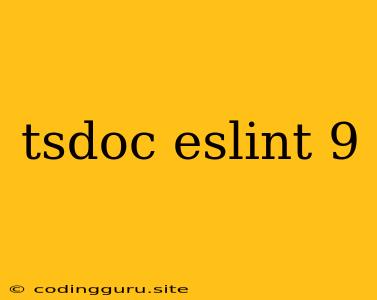Demystifying TypeScript Documentation with tsdoc and ESLint 9
TypeScript, the beloved superset of JavaScript, offers powerful features for building robust applications. One often overlooked aspect is documenting your code effectively. This is where tsdoc and ESLint 9 come in, working in tandem to elevate your TypeScript code documentation to a new level.
What is tsdoc?
tsdoc is a specialized documentation format specifically designed for TypeScript. It provides a structured way to annotate your code, making it more readable and understandable. This helps you maintain your codebase, collaborate with other developers, and even generate comprehensive documentation automatically.
Why Use tsdoc with ESLint 9?
ESLint 9 introduces the @typescript-eslint/parser which enables you to enforce documentation style and consistency across your codebase. By combining tsdoc and ESLint 9, you gain several benefits:
- Enhanced Readability: tsdoc tags offer a structured way to document your code, making it easier to understand the purpose of functions, classes, and variables.
- Automatic Documentation Generation: You can use tools like Typedoc to automatically generate documentation websites from your tsdoc annotations.
- Code Quality Improvement: ESLint 9's @typescript-eslint/parser ensures that your documentation adheres to a consistent style, preventing errors and improving code quality.
- Better Collaboration: Well-documented code is easier for other developers to understand, leading to improved collaboration and reduced development time.
Setting Up tsdoc and ESLint 9
-
Install Necessary Packages:
npm install --save-dev @types/tsdoc @typescript-eslint/parser @typescript-eslint/eslint-plugin eslint-plugin-tsdoc -
Configure ESLint:
In your .eslintrc.js file, add the following:
module.exports = { parser: '@typescript-eslint/parser', plugins: ['@typescript-eslint', 'tsdoc'], extends: ['plugin:@typescript-eslint/recommended', 'plugin:tsdoc/recommended'], rules: { 'tsdoc/syntax': 'warn', // Enforce tsdoc syntax 'tsdoc/require-jsdoc': 'warn', // Ensure documentation is present 'tsdoc/tag-casing': 'warn', // Ensure tag names are consistent // ... other rules }, }; -
Write Your Documented Code:
Here's an example of how to use tsdoc within your TypeScript code:
/** * Calculates the sum of two numbers. * * @param a - The first number. * @param b - The second number. * @returns The sum of the two numbers. * @example * sum(2, 3) // returns 5 */ function sum(a: number, b: number): number { return a + b; }
Examples of tsdoc Tags
tsdoc offers a rich set of tags to provide comprehensive documentation:
- @param: Describes the parameters of a function.
- @returns: Explains the return value of a function.
- @example: Provides an example demonstrating how to use a function.
- @throws: Describes potential exceptions that might be thrown.
- @author: Specifies the author of the code.
- @version: Indicates the version of the code.
Troubleshooting
ESLint 9 and tsdoc are powerful tools, but you might encounter some common challenges:
- Error: Cannot find module '@types/tsdoc'.
- Ensure you have installed the @types/tsdoc package.
- ESLint doesn't recognize tsdoc tags.
- Check that the @typescript-eslint/parser is properly configured in your .eslintrc.js file.
- ESLint doesn't enforce tsdoc rules.
- Verify that the tsdoc plugin is enabled and the appropriate rules are defined in your .eslintrc.js file.
Conclusion
tsdoc and ESLint 9 are indispensable tools for writing well-documented TypeScript code. They promote code clarity, consistency, and collaboration, leading to a more maintainable and robust codebase. By embracing these tools, you can elevate your TypeScript development experience to new heights.
